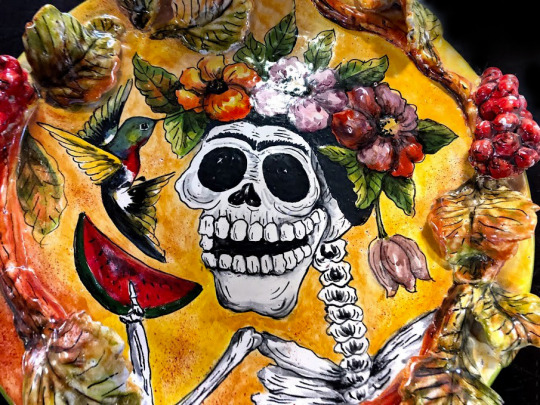Text
National Geographic in Bhutan: Dochula Pass
DOCHULA PASS, Bhutan–On top of a high pass through the Himalayas (10,171 feet), on the road from Thimphu to Punakha, looking down on clouds, is a concentration of 108 chortens built in memory of Bhutanese soldiers killed in the 2003 war against insurgents from India. Each stupa contains sacred icons and texts, linking heaven with earth.
Bhutan’s Queen Mother, Ashi Dorji Wangmo Wangchuck, commissioned the monument after King Jigme Singye Wangchuck was victorious in the struggle to dislodge rebels using Bhutan as a base to raid India.
Gangkhar Puensum (24,740 feet), said to be the highest unclimbed mountain on Earth, can be seen from Dochula Pass. On the far side of that peak lies Tibet.
The National Geographic Committee for Research and Exploration, in Bhutan to meet with grantees, was briefed by the King, government officials and environment groups. Our delegation also observed science, exploration, and conservation in the field, passing through Dochula while traveling back and forth between Bhutan’s modern and ancient capitals.
Originally published December 1, 2014
Photos by David Max Braun
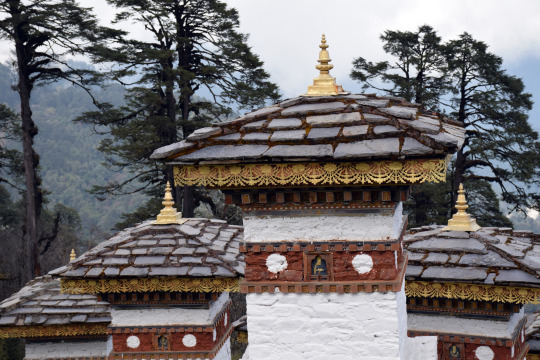

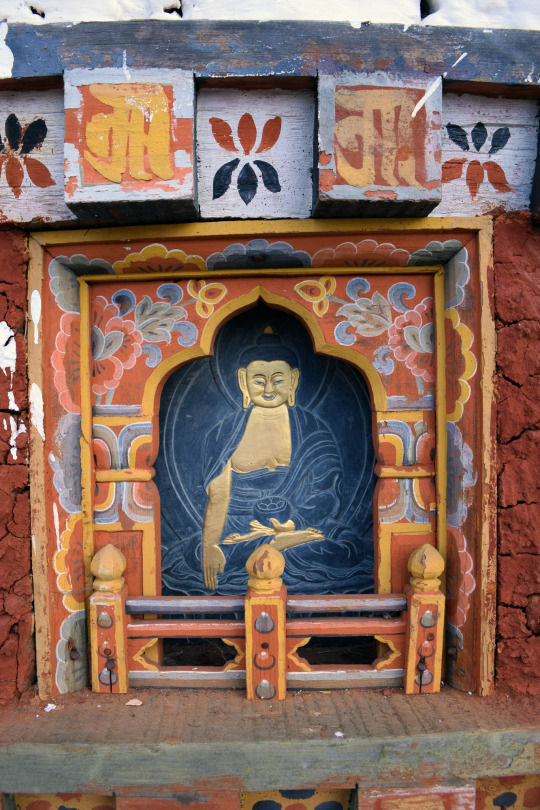
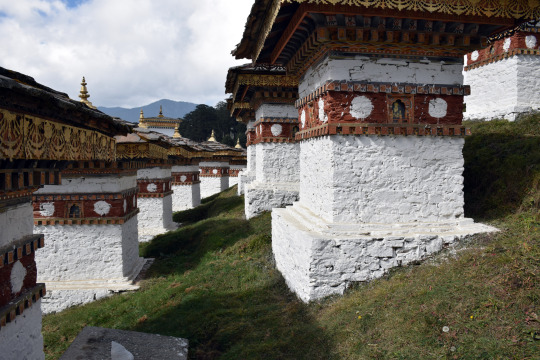
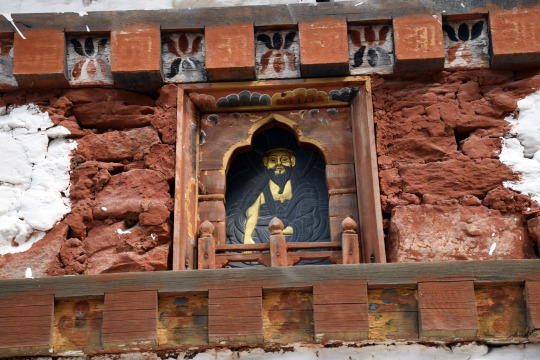
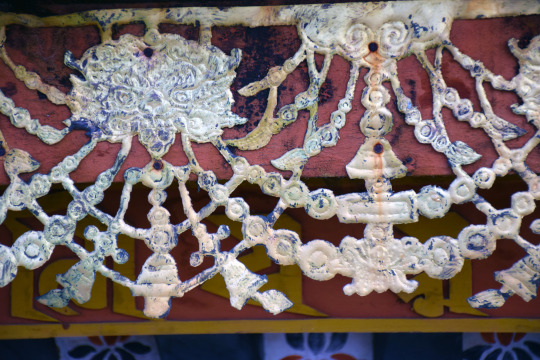

#Himalayas #Bhutan #exploration #Dochula Pass
0 notes
Text
Ascending Bhutan’s Sacred Tiger’s Nest
First published on November 30, 2014
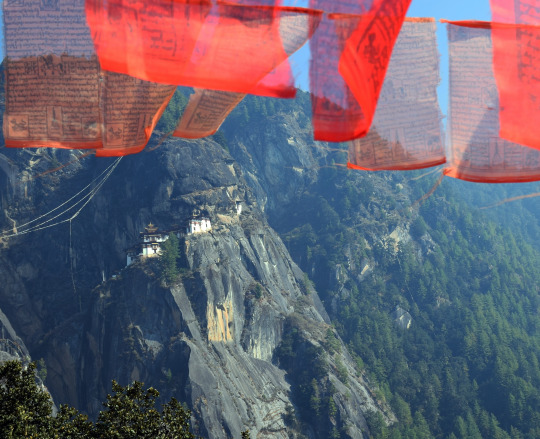
Taktsang monastery on the side of a mountain overlooking Paro Valley in Bhutan. The World Heritage site is featured prominently in the National Geographic book “Sacred Places of a Lifetime,” a showcase of the world’s most powerful and spiritual places. Photograph by David Braun.
PARO, Bhutan–It’s a steep climb to Paro Taktsang, a Himalayan Buddhist monastery hugging the side of a rocky cliff 3,000 feet above the Paro valley in Bhutan. It requires ascending a thousand steps or more, but the path is well constructed and maintained, and the mountain air is fresh and cool. There are plenty of opportunities to stop to admire the spectacular surroundings, making the ascent quite enjoyable if taken slowly.
For those of us who live at sea level it can be difficult to breathe comfortably while exercising vigorously at 10,000 feet, so a relaxed pace with plenty of rest is definitely the way to make this pilgrimage, as advised by our expedition leader, Bill Jones.
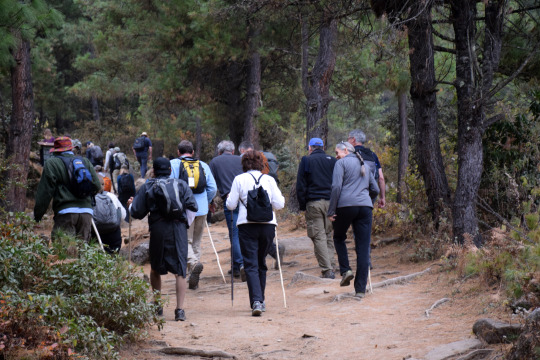
The National Geographic Committee for Research and Exploration at the start of the hike up to Taktsang monastery. Photograph by David Braun.
The pilgrimage to Taktsang, also known as Tiger’s Nest or Tiger’s Lair, is (literally and figuratively) the high point of any visitor’s sojourn in Bhutan. For the National Geographic Committee for Research and Exploration delegation, it was the final stop of a week-long visit that had taken us around the western part of the kingdom, visiting dzongs (monastery fortresses), temples, and the wintering grounds of extremely rare white-bellied herons and black-necked cranes. We’d had plenty of time to acclimate to the altitude and there had been at least two long walks through farms and villages to prepare us for the steep climb to the Tiger’s Nest.
Flying in on a Tigress
Taktsang is said to be the holiest site in Bhutan. It’s where Guru Rinpoche, also known as Padmasambhava, materialized some 1,300 years ago on the back of a flying tigress. Finding shelter in a series of caves, he meditated for some three years and then set about converting the Bhutanese to Buddhism.
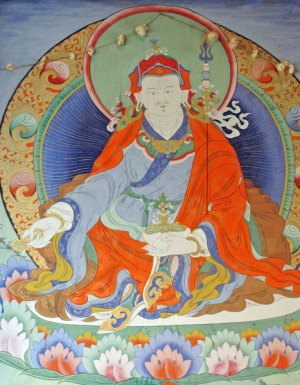
Wall painting of Padmasambhava on Paro bridge. Image by by Baldiri, Wikimedia Creative Commons.
The monastery that commemorates this auspicious beginning was built nine centuries later, in the 1600s, although the buildings we see today have been replaced several times, including major reconstruction completed in 2005 after a fire devastated the structure and its contents in 1998.
Ever taking the long view, the Bhutanese point out that buildings are temporal and meant to be renewed; the ideas and philosophies they represent cannot be destroyed.

Photograph by David Braun.
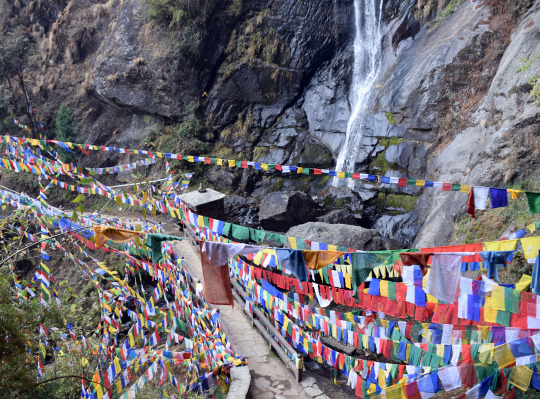
Thousands of prayer flags frame a 200-foot waterfall below the Tiger’s Nest Monastery. Photograph by David Braun.

Small reliquaries or “tsa-tsas” containing ashes of the dead on ledges in the vicinity of Tiger’s Nest. Photograph by David Braun.
The final approach to the monastery after a climb of around two hours is over a bridge across a waterfall that drops 200 feet into a sacred pool. The entire area is wrapped in prayer flags, while crevices in the rock are crammed with tsa-tsas, small reliquaries made from ashes of the dead. One last brutal flight of steep steps hewn out of rock delivers pilgrims to the monastery, which for our visit was blanketed in low-hanging cloud, adding an aura of heaven to the place.
Entry to the sanctuary is granted on condition that shoes, cameras, cell phones and other electronic equipment are left at the gates. A security guard patted us down to make sure we were not smuggling cameras and he instructed us to button our jackets as a mark of respect for the holy place. Inside we were given a tour of various temples and other chambers crammed with Buddhist icons and heaped offerings of food and money. Flickering traditional butter lamps cast a warm ethereal light.
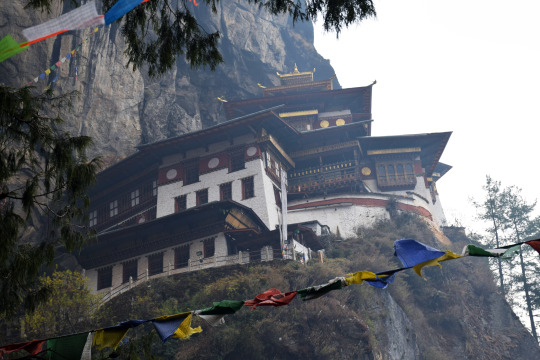
Taktsang’s main structures were rebuilt after a fire all but destroyed the complex 16 years ago. A consortium of international donors restored the site to its former glory in 2005. Photograph by David Braun.
Holy Water
In one temple we encountered a monk watching over a door sealing the cave used by Padmasambhava all those centuries ago. It is opened only once a year in a special ceremony, perhaps like Easter Sunday in the Vatican’s St Peter’s basilica. The monk blessed us and poured saffron-laced water into our hands which we brought to our lips and splashed on the crown of our heads. In the next sanctuary we found a monk chanting sacred texts. He too splashed holy water into our hands for our mouths and heads, and he offered us something to eat.
We were alone in the third room we visited. Our guide stood with us at the door and explained the chamber’s purpose and the iconography on the altar, including a sitting statue of Padmasambhava. Then he invited us to sit quietly on the floor and meditate a while about where we were and what we were seeing and experiencing.
I became conscious of the complete silence of our situation in the clouds thousands of feet up on the side of a mountain deep in the Himalayas.
Cross-legged comfortably on a mat, feet pointed in respectfully, I first thought what a difference it made to be looking at the icons without the encumbrance of a camera. I became conscious of the complete silence of our situation in the clouds thousands of feet up on the side of a mountain deep in the Himalayas.
As I listened to the silence and stared into the fierce eyes of one of the statues my mind shifted abruptly; into my head came the memory of my mother who passed away 34 years ago, and I thought how much she, a Buddhist at heart, would have wanted to visit this remarkable holy shrine. Just then a bird trilled loudly from the ledge of an open window right behind me, and I imagined it was my mother’s way of telling me that she heard me, and that she was with me in this special place.
It is not uncommon for people to have some kind of spiritual experience at Taktsang, Bill Jones, our expedition leader, told me after we had left the monastery. Bill has led groups to Bhutan more than a hundred times, taking perhaps a thousand people up to the shrine. “I can’t tell you how many people have told me that something happened to them spiritually up there,” he said when I told him my story about the bird and thoughts of my mother.
I also learned that the bird that had interrupted my reverie was a rufous-breasted accentor (Prunella strophiata), a common resident throughout the Himalayas. (You can listen to its song here.)

The two-hour stroll up the mountain to Taktsang is through forests of rhododendron and pines, with many birds and smaller animals to be enjoyed. Photograph by David Braun.
Birds are abundant in Bhutan. Everywhere we went we saw crows on houses and monasteries. We learned that schools had been relocated and electricity cables buried to make wetlands safe for the black-necked cranes (Grus nigricollis) that migrate from the Tibetan Plateau, where they breed in the summer.
To make this annual journey, the cranes must fly through extremely harsh conditions over the world’s highest mountains. Residents of Phobjikha say they see the birds circle Gangteng Monastery three times when they arrive at the valley’s marshes for the winter, and three times again when they begin their return. It’s one more spiritual connection between the people and wildlife of Bhutan.
Led by the royal family, the government has committed to protecting Phobjikha Valley for the cranes, and also to keeping more than half of the rest of the country as natural forest. Wildlife corridors have also been set aside for elephants, tigers, leopards, and all the animals smaller than them, to be able to migrate freely between national parks in both Bhutan and neighboring India.
Surrounded entirely by China and India, the two most populous nations on Earth, Bhutan’s isolation and its ancient spirituality have enabled the country to hang on to much of its culture and natural heritage.
But as the country continues to modernize and open to the world, Bhutan will be challenged to stay this way. The teachings brought to Taktsang by Padmasambhava 1,300 years ago include belief in the power and value of nature. Keeping the faith might be what empowers the country to choose the right way forward.
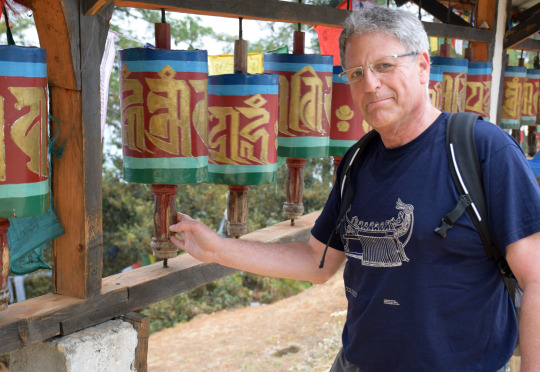
National Geographic President and CEO Gary Knell spins prayer wheels prior to hiking to the Tiger’s Nest monastery. Photograph by David Braun.
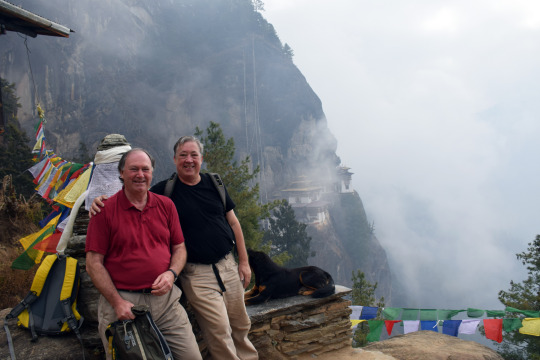
CRE member Keith Clarke (left) and David Braun pause for a photo en route to Tiger’s Nest. We did not know anything about the beautiful dog sitting serenely next to us. Photograph courtesy of David Braun.
National Geographic President and CEO Gary Knell led the Committee for Research and Exploration on a tour of the Himalayan kingdom to meet with grantees, listen to briefings from government officials and environment groups, and observe science, exploration, and conservation in the field. The delegation visited dzongs and other religious places, wildlife sites, and had an audience with King Jigme Khesar Namgyel Wangchuck. The Society has funded nearly two dozen research projects in Bhutan, two of which were active at the time of the National Geographic visit. National Geographic published its first article about Bhutan in 1914: a compelling account of explorations and surveys by John Claude White, a British Raj administrator and an accomplished amateur photographer. Read (and enjoy the 100-year-old photos) here: Castles in the Air: Experiences and Journeys in Unknown Bhutan
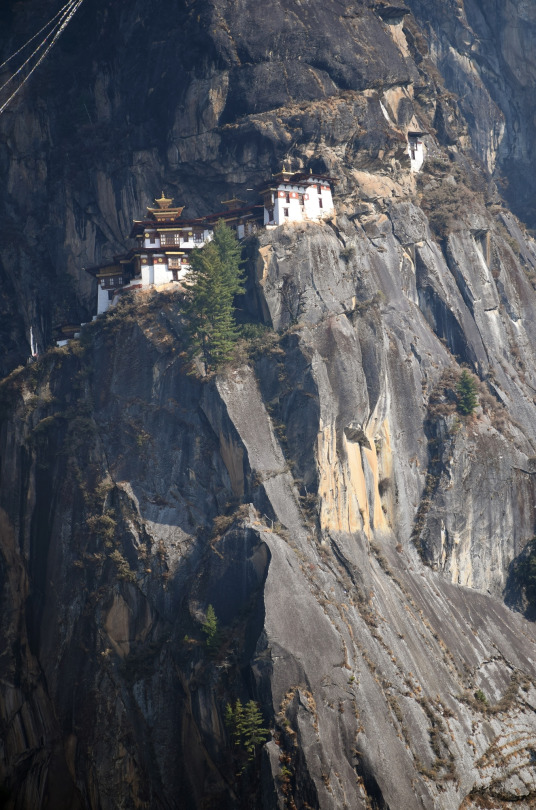
Taktsang is built on a series of ledges on near vertical rock cliffs thousands of feet above Paro. The monastery is some 10,000 feet above sea level. Photograph by David Braun.
#bhutan#taktshang monastery#tiger’s nest#paro#world heritage site#national geographic#guru rinpoche#padmasambhava#buddhism#prayer flags#himalayas#birds
0 notes
Text
Conversation with Bhutan’s Young “Dragon King”
First published on November 17, 2014
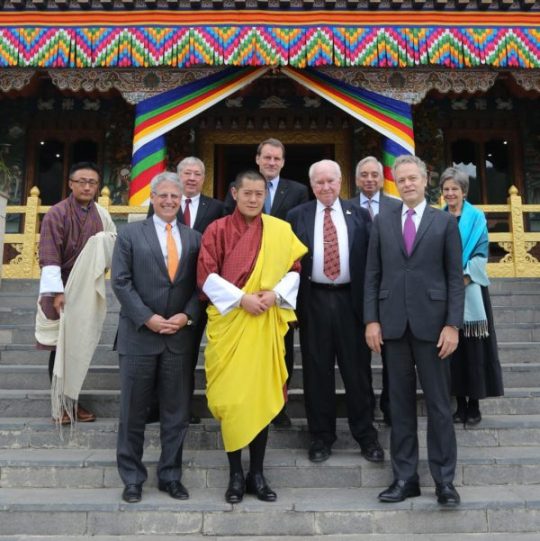
King Jigme Khesar Namgyel Wangchuck with the National Geographic delegation, November 17, 2014. From left: Tshewang Wangchuk, Gary Knell, David Braun, His Majesty the King, John Francis, Peter Raven, Kamal Bawa, Terry Garcia, Carol Harden. Photo Courtesy of the Royal Media, Kingdom of Bhutan
THIMPHU, Bhutan–King Jigme Khesar Namgyel Wangchuck is a young ruler connected deeply with the digital universe while remaining anchored in the teaching and wisdom handed down through generations. He surfs the Web to gauge the mood of the people, following the conversations of his subjects and engaging them through social media. He has his own Facebook page, and he knows about National Geographic’s Bhutan website from perusing it on his iPhone.
From what he calls the attic of the world, his small Buddhist country high in the Himalayas, the world’s tallest mountains, Bhutan’s constitutional monarch also monitors events outside his kingdom; he is very well informed about what is going on in the world, even following American sports teams.
The King is proud that Bhutan is able to navigate the daunting development challenges facing his country while remaining true to the legacy of its past, which includes a commitment to preserving the kingdom’s natural heritage. Sixty percent of the country, which is half the size of Virginia, remains forested. Sanctuaries set aside for elephants, big cats and other wildlife are connected by corridors. It’s a development path Bhutan’s kings chose for their people, although the current monarch acknowledges it is not easy or instinctive to always know the best way forward.
His Majesty received a delegation of National Geographic executives and scientists today, noting “with gratitude” that the Society had been promoting his country for 100 years. (Read the article published by National Geographic magazine in 1914, Castles in the Air: Experiences and Journeys in Unknown Bhutan.)
Meeting us in his office in Bhutan’s parliamentary complex, in the capital city Thimphu, the 34-year-old “Dragon King” treated the National Geographic team to a cup of fragrant tea and a wide-ranging conversation about his country, international conservation, and global challenges and opportunities for the people of Bhutan, especially the youngest generations.
National Geographic President and CEO Gary Knell is leading the Society’s Committee for Research and Exploration (CRE) on a tour of the Himalayan country to meet with grantees, listen to briefings from government officials and environment groups, and observe science, exploration, and conservation in the field. The Society has funded nearly two dozen grants in Bhutan, two of which are active.
Building Bridges
Knell told the king that National Geographic was in Bhutan “to build bridges and understand what people want and how we can help them with training and in other ways.” CRE Chairman Peter Raven added that the Society had been awarding grants for a century in all countries. “Any citizen from any country is eligible,” he said.
A keen photographer himself, King Jigme Khesar Namgyel Wangchuck said he had studied the images of Bhutan published by National Geographic magazine in 1914. “In so many ways I am gratified when I go through the photos of John Claude White of the many places and people he saw a hundred years ago. I see that although we have embraced modernity and change we have also been able to preserve our culture. Almost all the dzongs [fortresses] and temples are in almost the same state today as when Claude White photographed them.” The thoroughly modern monarch noted that he did not have a physical copy of the April 1914 issue of National Geographic; he studied the photos and article on his iPhone.
Gary Knell said National Geographic’s model is education. The magazine is published in 41 languages but, as the king had demonstrated, millions of people read National Geographic’s content in digital media, where the Society is publishing on a daily and hourly basis. “This is part of how we also are modernizing after 125 years while keeping the traditions of our founders,” he said.
Age of Exploration
A century ago many parts of the world remained unknown and undiscovered, the royal host observed. “There could be few places today that have not been discovered, yet National Geographic still has a role to inform people about the world.” Terry Garcia, National Geographic’s Chief Science and Exploration Officer, countered that the Society believes that the 21st century is the greatest age of exploration because technology is opening doors once believed permanently closed, including in the fields of archaeology and paleontology. “For scientists and explorers it is a very exciting time to be alive,” he said.
Peter Raven added that of the estimated 12 million organisms believed to exist on Earth, only around 2 million have been named scientifically, and at least half of them are at risk of becoming extinct within the remainder of the 21st century. In Bhutan alone, there are an estimated 200,000 organisms, excluding bacteria, and so far only about 12,000 have been identified. Land use and climate change are threatening to destroy species before they can be understood, so there is an urgent need to move quickly and understand all that is out there, he said.
National Geographic Vice President for Research, Conservation and Exploration John Francis told the king that Tshewang Wangchuk, a Bhutanese recipient of a National Geographic research grant who accompanied the delegation to meet the monarch, is studying the country’s snow leopards with camera traps and DNA analysis, tools not available to researchers 20 years ago.
Fingers Crossed for a Sighting of Yeti
The king said he regularly receives camera trap images and videos produced by researchers in Bhutan. “We have been talking and hearing about clouded leopards in Bhutan for 100 years, so it is astonishing for us to see video of clouded leopards and discover how healthy they are and that their numbers are growing. The same is true also for snow leopards. I am keeping my fingers crossed, in a humorous way, that maybe we will still get an image of Yeti in a camera trap.”
“That would probably make the home page of our website,” Terry Garcia quipped.
Tshewang Wangchuk observed that research has also established that tigers live and breed in Bhutan, demonstrating that the country plays a critical role for the survival of all the big cats in the Eastern Himalayan region.
CRE member Carol Harden, a professor of geography from the University of Tennessee, noted that Bhutan is critical also for the freshwater of the region as many of the rivers start in the kingdom. The king said that there is still much to learn about the aquatic organisms in Bhutan’s lakes and rivers, “but we have not yet acquired the technology or expertise to make this exploration.”
The monarch then drew attention to another vital contribution Bhutan makes to the region through the establishment of wildlife corridors for elephants, tigers, birds and many other animals. The corridors link the country’s wildlife reserves and it is planned that they will also connect with corridors in India. “Biological corridors have become a No. 1 priority,” he said.
Wonder and Worry
Gary Knell said he liked to tell National Geographic colleagues that the Society should always inspire “wonder” and “worry,” to move information both in a positive direction to inspire change and also to make people concerned enough to make the right decisions. He asked the king what made him wonder and what made him worry.
“My chief wonder would certainly be the future,” the king said, noting that at 34 years old he is married and hopes to have children and “a beautiful journey as a family.” For his people, he hopes for modern medicine, technology and interesting lives. “But I worry about how we navigate collectively.” It is difficult to understand how 600,000 citizens should know instinctively what to do, whether to turn left or right, or make a leap, he explained. “We must know the risks and we must know whether that kind of decision-making comes instinctively. Looking back at my predecessors, I would say that their navigation was very successful. We have to know how to take advantage of that so that our generation can also be successful. I am very optimistic.”
“We have a tool to help you navigate,” John Francis declared. It was an opportune moment to present to the king a copy of the new 10th edition of National Geographic’s Atlas of the World. Kamaljit Bawa, member of the CRE, distinguished professor of biology at the University of Massachusetts, Boston, and founder of Ashoka Trust for Research in Ecology and Environment (ATREE) of Bangalore, India, presented the king with a copy of his book Himalaya: Mountains of Life, explaining to His Majesty that there was a section about Bhutan.
King Jigme Khesar Namgyel Wangchuck asked all present to sign the National Geographic atlas, which he said he will add to his personal collection. “I want each one of my books to have its story,” he said, adding that at some point he wanted to turn the book collection over to a library where it could be used to inspire young people to read. Reading books is a skill and tradition he does not want the digital generation to lose.
Jigme Khesar Namgyel Wangchuck is the Druk Gyalpo or "Dragon King" of the Kingdom of Bhutan. After his father Jigme Singye Wangchuck abdicated the throne in his favour, he became the monarch on 9 December 2006.
#Bhutan #Bhutan environment #Jigme Khesar #National Geographic
0 notes
Quote
The less people know, the more stubbornly they know it...The more you understand, the less you realize that you know.
Osho
0 notes
Quote
I know only one thing: that I don’t know anything at all.
Socrates
0 notes
Quote
Most people believe the mind to be a mirror, more or less accurately reflecting the world outside them, not realizing on the contrary that the mind is itself the principal element of creation.
Rabindranath Tagore
0 notes
Quote
Meditation brings wisdom; lack of meditation leaves ignorance.
The Buddha
1 note
·
View note
Quote
Health is the most precious gift
and contentment the greatest wealth.
A trustworthy person is the best kinsman,
Nibbana the highest bliss.
The Buddha
0 notes
Quote
If you don’t tend to one another, who then will tend to you?
The Buddha
0 notes
Quote
In the end, it's not the years in your life that count. It's the life in your years.
Abraham Lincoln
0 notes
Quote
There is nothing either good or bad but thinking makes it so.
William Shakespeare
0 notes
Quote
We cannot solve our problems with the same thinking we used when we created them.
Albert Einstein
0 notes
Quote
The teacher who is indeed wise does not bid you to enter the house of his wisdom but rather leads you to the threshold of your mind.
Kahlil Gibran
0 notes

